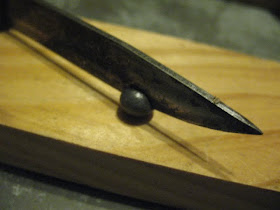

A float or strike indicator is not at all necessary for fishing. I've caught many a trout with a fly rod and no strike indicator, but an indicator does make it easier to know when you're getting a bite, and if you are fishing multiple lines you almost have to have an indicator. Remember a float is not just to see if you are getting a bite. It also serves to keep your bait suspended at a certain level in the water.
If you are making floats at home you can use old wine corks to make some good ones. Use a sharp knife to cut the corks about an inch to an inch-and a-half long, then drill about a quarter inch hole through the corks. This the hardest part because the corks will want to split if you go too fast. I actually made a little tool to drill corks with. I took a piece of quarter inch metal tubing about 3 inches long and filed little teeth into one end. I chuck this up in my drill and drill very slowly through the cork. Pictured below: Drilling a cork with my home-made bit and cork with finished hole.


Once you have your cork drilled you can cut a small stick that will fit tightly in the hole. Don't make the stick too oversize or you may split the cork when you push the stick in. Pictured below: Cork and stick, finished assembled float, and float attached to linen fishing line.



I saw an article recently that showed how to make floats out of dried corn cobs. Basically the same procedure as above but you use a section of dried corn cob instead of a cork. I haven't tried this one yet, but it sounds reasonable. I plan to save a few cobs out of my garden this year and give it a try.
No comments:
Post a Comment